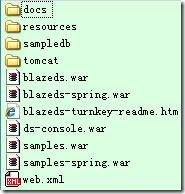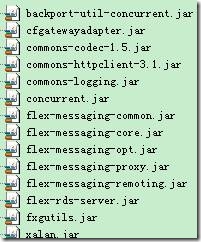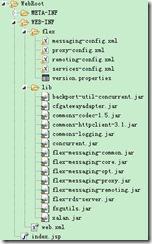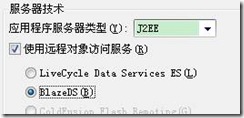BlazeDS 整合 Flex HelloWorld 示例
开发环境:
System:Windows
WebBrowser:IE6+、Firefox3+
JavaEE Server:tomcat5.0.2.8、tomcat6
IDE:eclipse、MyEclipse 8
Flex IDE:Flash Builder 4
BlazeDS:4.5
开发依赖库:
JavaEE5、blazeDS 4.5
Email:hoojo_@126.com
Blog:http://blog.csdn.net/IBM_hoojo
一、准备工作
1、 首先要提供相关的jar包
Java服务器端需要提供BlazeDS相关的配置和jar包
下载地址:http://opensource.adobe.com/wiki/display/blazeds/download+blazeds+trunk
下载后,解压你可以看到这样的一个目录
Docs就是文档
Resource是源码
SampleDB是示例用的数据库,可以运行startdb.bat来启动数据库
Tomcat是内置的tomcat,如果你没有tomcat的话可以使用它,在tomcat的webapps目录中有samples示例
blazeds.war就是blazeDS的核心文件、库,你可以把这个war放到tomcat的webapps目录下,就会自动解压。当然你也可以自己手动解压。
Blazeds-spring.war是和spring整合的配置
Ds-console.war是blazeDS的控制台程序
Samples.war是官方提供的示例
Samples-spring.war是spring和blazeDS的整合示例
二、部署服务器端程序
1、新建一个JavaWeb Project工程,然后在WEB-INF/lib目录中添加如下jar包
这些jar包可以在blazeds.war包中的lib目录中可以找到
2、 然后你需要将blazeds.war包中的WEB-INF目录下的flex目录复制到当前工程的WEB-INF下
3、 将blazeds.war包中的WEB-INF目录下的web.xml的配置,添加到当前工程的web.xml文件中
4、 最后基本的样式如下
5、 最后你发布当前工程,如果没有错误就表明你服务器端部署成功了。
6、 编写一个HelloWorld的java程序。代码如下
package com.hoo.flex;/** * <b>function:</b> HelloWorld Example * @author hoojo * @createDate 2011-8-31 下午06:11:27 * @file HelloWorld.java * @package com.hoo.flex * @project BlazeDSServer * @blog http://blog.csdn.net/IBM_hoojo * @email hoojo_@126.com * @version 1.0 */public class HelloWorld {
public HelloWorld() {}
public String sayHello(String name) {return "[" + name + "] say hello!";
}
}
就一个sayHello方法,接收一个参数。
三、Flex客户端程序
1、创建一个Flex工程,在选择服务器技术的时候,你需要选择J2EE。然后勾上使用J2EE技术,然后选择BlazeDS。点击Next下一步
2、配置根文件夹,也就是JavaEE服务器端发布程序在tomcat中的位置。我这里是在tomcat的webapps的BlazeDSServer中,BlazeDSServer是我的服务器端程序。根URL是访问服务器端程序的url;上下文目录对应工程名称;最后就是输出文件夹目录,这个是Flex的文件最后在tomcat中保存的目录。
3、最后你需要设置服务器端的services-config.xml的路径到编译参数中,这个很重要!如果你不设置的话,那么你在后面用RemoteObject调用BlazeDS的时候,就需要设置endpoint。设置如下:
-services是参数键,后面的字符串是值。我这里是设置BlazeDSServer发布到tomcat目录中的services-config.xml的路径。
4、编译Flex前端代码,代码如下:
<?xml version="1.0" encoding="utf-8"?>
<mx:Application xmlns:mx="http://www.adobe.com/2006/mxml" viewSourceURL="BlazeDSHelloWorld.mxml" layout="absolute" minWidth="955" minHeight="600">
<mx:Script>
<![CDATA[import mx.controls.Alert;
import mx.rpc.AsyncToken;
import mx.rpc.events.ResultEvent;
private function faultHandler(event: Event): void {Alert.show(event.toString(), event.type);
}
private function resultHandler(event: ResultEvent): void {//event.result是服务器端返回对象
result.text = "Message:" + event.result.toString();
}
private function sendHandler(): void {helloRemoteObject.sayHello(userName.text);
}
]]></mx:Script>
<!-- 当工程没有设置编译器-service参数 或是-context-root等参数,就需要手动设置endpoint参数 --><mx:RemoteObject
id="helloRemoteObject"
destination="helloWorld"
fault="faultHandler(event)"
result="resultHandler(event)"
showBusyCursor="true"/>
<mx:Panel x="10" y="10" width="272" height="148" layout="absolute" title="BlazeDS Remote HelloWorld Sample">
<mx:Label x="10" y="22" text="请输入名称"/>
<mx:TextInput x="70" y="19" id="userName"/>
<mx:Button x="184" y="45" label="发送" click="sendHandler()"/>
<mx:Text x="10" y="79" id="result"/>
</mx:Panel>
</mx:Application>
首先你需要将Java服务器端的HelloWorld程序配置在flex的remoting-config.xml中,配置如下:
<?xml version="1.0" encoding="UTF-8"?>
<service id="remoting-service"
class="flex.messaging.services.RemotingService">
<adapters>
<adapter-definition id="java-object" class="flex.messaging.services.remoting.adapters.JavaAdapter" default="true"/>
</adapters>
<default-channels>
<channel ref="my-amf"/>
</default-channels>
<destination id="helloWorld">
<properties>
<source>com.hoo.flex.HelloWorld</source>
</properties>
</destination>
</service>
上面mxml代码中的RemoteObject的destination对应的就是remoting-config.xml配置文件中的destination的id。这个是一一对应的,然后在sendHandler方法中,helloRemoteObject对应的就是RemoteObject的id,而sayHello方法对应的就是配置在remoting-config.xml中的destination的source的Java服务器端代码的公有方法。添加完配置后,需要重启tomcat。
运行上面的flex程序后,如果输入参数后,点击发送,可以看到服务器端返回的消息就说明BlazeDS整合Flex成功了。
出处:
blog:http://blog.csdn.net/IBM_hoojo
本文版权归作者和博客园共有,欢迎转载,但未经作者同意必须保留此段声明,且在文章页面明显位置给出原文连接,否则保留追究法律责任的权利。
版权所有,转载请注明出处 本文出自:








 浙公网安备 33010602011771号
浙公网安备 33010602011771号